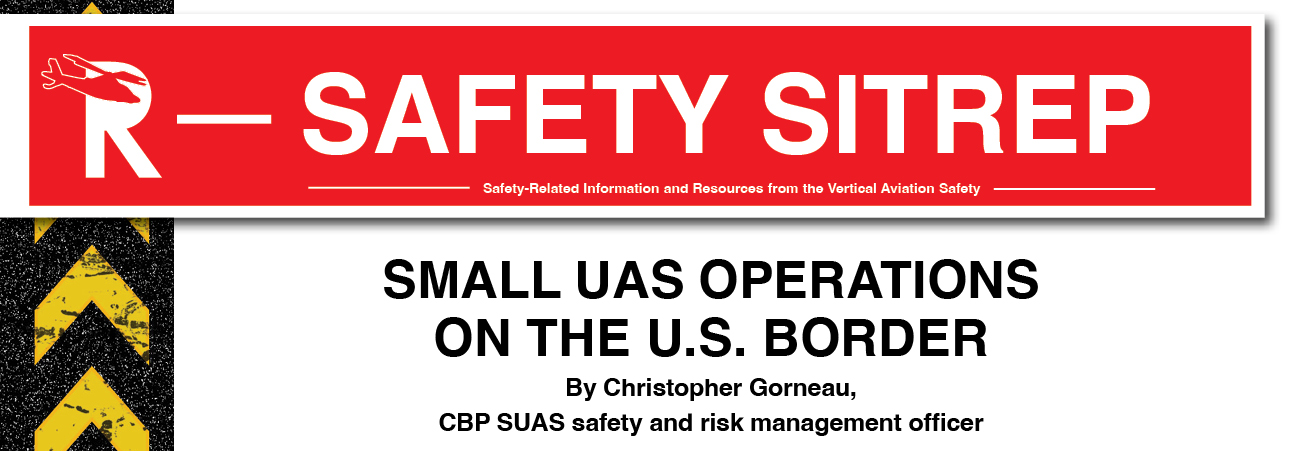|
Jul
22
2024
|
|
Posted 1 years 148 days ago ago by Admin
|
|

Article by: Christopher Gorneau, CBP SUAS safety and risk management officer
Small Unmanned Aircraft Systems (SUAS) have become indispensable assets for U.S. Customs and Border Protection (CBP), thanks to their unique capabilities that significantly enhance operational effectiveness. These systems occupy a critical operational niche, bridging the gap between fixed surveillance infrastructure and manned aircraft. The inherently low acoustic profile and smaller size of SUAS allows them to operate nearly undetected, providing real-time intelligence, which is critical for situational awareness and operational planning. The information collected through SUAS aids in the detection, tracking, identification, and resolution of illegal activities, such as smuggling or unauthorized border crossings. Moreover, SUAS enhance the safety of CBP personnel by allowing them to conduct reconnaissance and surveillance missions from a distance without exposing agents to direct threats or hazardous environments.
With over 7,000 miles of border to monitor, these technological assets provide a force-multiplier to our agents and officers across challenging and often remote terrain. Selecting the appropriate SUAS for the varied and complex environments that CBP operates in is essential. Factors such as endurance, sensor capabilities, redundancy, resistance to environmental conditions, NDAA compliance, and ease of deployment are considered. The careful selection and deployment of these systems facilitate more effective border security operations, ultimately contributing to the safety and security of the nation.
Cost-effectiveness is also a prominent advantage of using SUAS over traditional manned aircraft. The operational costs—encompassing fuel, maintenance, and personnel—are markedly lower with SUAS. The use of SUAS to augment air support missions in coordination with CBP’s manned aviation assets continues to provide border security efficacy across the broad spectrum of missions.
In 2023, CBP fielded approximately 400 unmanned aircraft along the southern and northern borders, and Puerto Rico, which collectively executed over 15,000 flight hours, averaging 28% of CBP’s comparable direct air support hours flown, accounting for 48% of air-assisted apprehension events. Besides the direct border security missions, CBP is expanding SUAS operations to inspect border infrastructure to include towers, fences, walls, and facilities, as well as to increase port security. This extensive deployment underscores the pivotal role that SUAS play in modern border security operations.
Looking forward, CBP is exploring several advancements in SUAS technology that could further elevate their operational capabilities. CBP is working closely with the FAA, academia, and industry on beyond-visual-line-of-sight (BVLOS) requirements, capabilities, and standards, to include detect-and-avoid (DAA) technologies, monitoring the UAS traffic management (UTM) developments, and government regulations. The integration of artificial intelligence (AI) stands out as a promising development. AI could automate the detection and tracking of items of interest, thereby increasing safety in the national airspace, providing operational efficiency, and enabling quicker responses to emerging threats.
The future also holds the potential for enhanced integration of SUAS operations with other assets, such as ground sensors and manned aircraft. This integration aims to create a more seamless and comprehensive surveillance network along the border. Such a network would help eliminate coverage gaps and ensure more coordinated and effective responses to security threats.
The strategic deployment of SUAS has fundamentally transformed CBP operations, providing a blend of capacity and capability, cost-efficiency, and enhanced safety for personnel. The current frequency of use highlights the significant impact these systems have had. As technology continues to advance, the capabilities of SUAS are poised to grow, offering even greater support to the mission of maintaining national security and border integrity. The ongoing integration of AI, advanced sensors, and improved communication systems will undoubtedly contribute to more effective and efficient border surveillance and response strategies, solidifying the role of SUAS as a cornerstone of modern CBP border security operations.
READ MORE ROTOR PRO: https://justhelicopters.com/Magazine
WATCH ROTOR PRO YOUTUBE CHANNEL: https://buff.ly/3Md0T3y
You can also find us on
Instagram - https://www.instagram.com/rotorpro1
Facebook - https://www.facebook.com/rotorpro1
Twitter - https://twitter.com/justhelicopters
LinkedIn - https://www.linkedin.com/company/rotorpro1